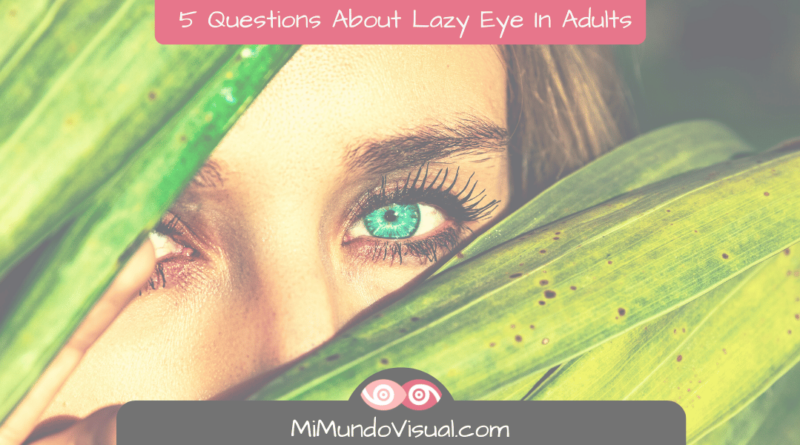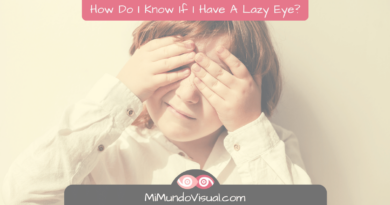5 Questions About Lazy Eye In Adults
Table Of Contents
Many questions arise when suffering from Amblyopia, more commonly known as lazy eye.
With this article, we would like to address some of those doubts and explore how having a lazy eye can affect us in adulthood.
For this purpose, we have prepared these 5 questions designed for adult amblyopes:

#1 Why is it so important to detect Amblyopia or Lazy Eye early?
Treating Amblyopia or Lazy Eye in children is essential, as it will be much easier to recover visual acuity during the visual development stage.
In the case of Amblyopia, the visual brain ‘has not learned to see yet,‘ and we say this because the defect is not in the eyes but in the brain’s visual areas. I
In fact, the reality is: We do not see with our eyes but with our brains.
The retina receives light stimuli and sends the information through the optic nerve to the brain. In the case of Lazy Eye, the brain does not receive clear and good-quality images, and Amblyopia develops.
Amblyopia is the loss of visual acuity, which means a loss of vision. If left untreated, it can also affect the vision of the healthy eye since it is forced to provide all the visual information.
Refractive errors (hyperopia, astigmatism, or myopia) can trigger Amblyopia because by creating different images in each eye, the brain will select the image that is sharper and discard the poorer quality.
But what happens if we haven’t been able to detect and treat Amblyopia in our childhood? Is there no solution and nothing we can do about it?
#2 Can Lazy Eye Be Treated in Adults?
After searching for a lot of information on the web and consulting with various eye doctors, we have noticed that most ophthalmologists do not recommend treating ‘Lazy Eye’ in adulthood.
They are of the view that this pathology has to be treated before the development of the visual system (which ends around the age of 8)
That is why we insist on regularly going to routine consultations with your children to detect it as early as possible.
However, we have found that some professionals and clinical studies promote the idea of using visual exercises to work on Amblyopia or Lazy Eye in adults, stimulating neuronal changes and, thus, using our remaining brain plasticity to improve the ability to see.
There have been several studies that assure that the lazy eye can also be treated in adulthood.
One example is a study conducted by Ben Thompson and his team, where a low-intensity electrical stimulation improved vision in adults suffering from Amblyopia, thus increasing their neuronal plasticity, allowing the brain to reorganize and change, in this way, its connections.
Another research that we have found encouraging has been carried out by Chinese researchers Chang-Bing Huang, Yifeng Zhou, and Zhong-Lin Lu, where they studied a total of 21 patients suffering from Amblyopia for 20 years. Different visual stimuli were projected on a computer, first with one eye and then with the other. They proved after 8 weeks of training that a vast improvement in spatial vision could be achieved by working the amblyopic eye with simple visual tasks.
Vision Therapy: Video Games and Virtual Reality
- AmblyoPlay – Game Therapy
- VisionaryTool – Game Therapy
- Virtual Reality and Games For Amblyopia Treatment At home!
Download Our Guide About Amblyopia!
#3 Why Is Amblyopia In Children Treated With Patching And Therapy In Adults?
The prognosis for Lazy Eye will always depend on the type of Amblyopia, the patient’s age when treatment is initiated, and the individual factors of the person.
However, Professor Robert Hess comments in his article ‘New hope for adults with amblyopia (lazy eye)‘ that Amblyopia has been treated for hundreds of years with patching and in many cases, all day long until very recently, when it has been proven that with fewer hours of occlusion, there were already improvements in vision by keeping the patch on for 6 to 24 months.
However, when the patch was removed, even though there was an improvement in visual function in most cases, there was insufficient binocular vision achieved in both eyes. This is because by covering one of the eyes (the healthy eye), a 3D image cannot be achieved subsequently, as it will suppress the lazy eye, reducing visual acuity. This is known as suppression.
He goes on to point out that occlusion of the eye is only functional up to 12 years of age, and eye patch treatment is not offered for adults. So a new treatment is presented to improve Amblyopia in the first instance and binocular vision in the second term.
They have found tools that can measure suppression, which shows a direct relationship between suppression and Amblyopia and that binocular vision is the main problem to be treated.
The two eyes do not work correctly together due to the defocusing of one of them or their misalignment, and this suppression causes the image of the lazy eye to be inhibited in order to avoid a double or blurred vision.
His method consists of measuring the degree of suppression and using a dichoptic presentation, with different images in each eye where suppression is minimal, under quite artificial conditions compared to natural visual conditions.
Professor Robert Hess along with Drs. Mansouri and Thompson observed that the longer the two eyes are trained together combining information, the stronger the binocular vision between the two eyes becomes. And after working for 4-6 weeks for 1 to 2 hours a day, they found that both eyes could work together in natural vision situations, improving 3D vision and visual acuity by eliminating the suppression of the healthy eye to the lazy eye.
What is most encouraging about this research is that it was performed on adults without existing treatment.
Surgery is often discussed as whether it is feasible for treating Amblyopia, but…
Vision Therapy Exercises
- Eccentric Circles
- Lifesaver Cards For Convergence And Divergence
- Mazes as Vision Therapy Exercises!
- Brock String
- Marsden Ball
- 5 Activities To Do While Wearing An Eye Patch
- Lazy Eye – 5 Games And Activities For Adults
Download Our Lazy Eye Guide!

#4 Is Amblyopia Operable?
We must distinguish Amblyopia from strabismus. Lazy Eye or Amblyopia does not refer to the eye deviation or the non-alignment of both eyes.
However, Amblyopia can be caused by strabismus. So if you go to the ophthalmologist and if they consider it appropriate, they will perform surgery to treat this deviation. Once the strabismus has been operated on, the weaker eye should continue to be treated.
Amblyopia can NOT be operated on, unlike strabismus, which can be operated on to correct a deviation. Surgery for Srabismus is possible for both adults and children.
Amblyopia cannot be corrected with glasses, contact lenses, or surgery.
But what happens if Amblyopia is left untreated?
#5 What are the consequences of not treating Lazy Eye in time?
The main consequence of Amblyopia is visual loss. Over time, the lazy eye may become blind since visual acuity and other skills, such as focusing, three-dimensional vision (depth perception), or contrast sensitivity, are affected.
It is important to strengthen the amblyopic or lazy eye when suffering from Amblyopia.
Even though the visual acuity problem or strabismus issue that triggers Amblyopia is treated with glasses, contact lenses, or surgery, the Amblyopia itself must be treated.
There is also a greater risk of suffering vision loss in the healthy eye, since the ocular problems that usually affect both eyes, will do so to a greater extent in this one. And if there is any subsequent pathology in this healthy eye, the lazy eye will not be able to replace that loss of vision.
Can Amblyopia return?
Once Amblyopia has been treated, the recovered vision can be lost, which is why it is important to continue to have regular check-ups to detect any anomaly in time and treat it.
However, as we can see, there is new hope for all those adult amblyopes who thought that lazy eye could no longer be treated once childhood has passed. Some studies support this idea, even though many doctors still believe that Amblyopia cannot be treated once the visual system has developed.
The good news is:
There may be an improvement in vision due to the plasticity of the brain and its ability to adapt.
Although there is no guarantee of success since each person and each situation is different. That is why discussing this with a vision professional who can advise us individually is essential.
More About Amblyopia or Lazy Eye
- How Do I Know If I Have A Lazy Eye?
- What Causes Amblyopia Or Lazy Eye?
- How To Detect A Lazy Eye?
- What is Amblyopia?
- 6 Eye Patch Therapy Inconveniences We Are Not Told About
- How To Choose The Best Eye Patch For My Child?
- Contact Lenses For Children With Lazy Eye!
- 5 Questions About Lazy Eye In Adults!
- Lazy Eye In Adults – Little Everyday Difficulties That May Be Due To Amblyopia!




